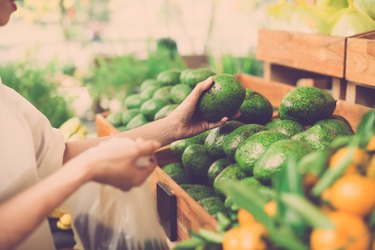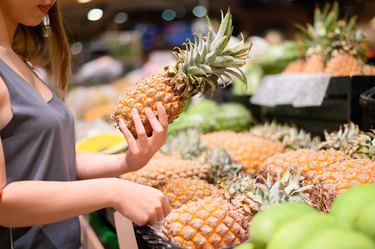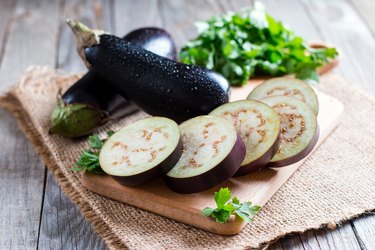
Vegetables and fruits are the backbones of a healthy diet — and foregoing them out of concern for pesticide exposure is a compromise you never want to make.
If you're concerned about pesticide residue contaminating your food, you can buy organic produce. But going organic can cost a pretty penny or isn't always accessible.
Video of the Day
Video of the Day
So if you had to choose which foods to buy organic, consider the Environmental Working Group's (EWG) annual Clean Fifteen list, which outlines the top 15 fruits and vegetables with the lowest amounts of pesticide residues. The EWG based its analysis on the U.S. Department of Agriculture's (USDA) recent data findings.
It's important to note that pesticide residue isn't necessarily a bad thing. In fact, the Environmental Protection Agency (EPA) regulates safe amounts of pesticide residue on food and that level is very small. The EPA also says that as crops are harvested, transported, washed and cooked, the amount of pesticide residue in the food is greatly reduced. But if pesticide exposure is keeping you up at night, here are the foods that are safest to buy conventional.
The Clean Fifteen List
1. Avocados
Good news for avocado toast lovers: The creamy fruit is the least contaminated with pesticides, with fewer than two percent of samples showing any detectable amounts.
Loaded with heart-healthy fats and vitamins K, E and C, as well as potassium, magnesium and calcium, avocados can easily replace mayo, cheese, butter and oil in many recipes. Toss avocado into a salad for some filling fats and fiber. Just 1 cup of sliced avocado delivers 9.7 grams of fiber, according to the USDA.
2. Sweet Corn
Taking the second spot on the Clean Fifteen list, sweet corn was also among the cleanest produce. Here's another reason you should eat this summer favorite year-round: A small ear of corn provides 27 milligrams of sleep-supporting magnesium and 197 milligrams of potassium, according to the USDA. It is also a good source of vitamin C, folate, choline and lutein.
3. Pineapple

Pineapple's thick skin absorbs most of the pesticides used on it, which means the flesh we eat is relatively clean.
The sunny fruit is an excellent source of vitamin C, delivering about 88 percent of your Daily Value (DV) in one cup, per the USDA. It also contains the enzyme called bromelain, which helps the body break down food and reduce inflammation, according to the National Institutes of Health.
4. Onions
There's no need to cry over conventionally grown onions from a pesticide standpoint. Onions are significantly lower in pesticide residue than other commercial produce.
In addition to enhancing the flavor of dishes, onions provide rich amounts of antioxidants. They also contain a flavonoid called quercetin, which may help inhibit the growth of H. pylori bacteria that underlies most stomach ulcers, per the National Onion Association. Eat onions fresh on sandwiches, burgers and salads, or as part of a nutritious base for soups, sauces and stir-fries.
5. Papaya
The vibrant orange color of papaya is an indication of its nutritional punch. A small papaya delivers 106 percent of your DV of vitamin C and 8 percent DV of vitamin A, according to the USDA. It also contains folate, beta-carotene and fiber.
Enjoy papaya boats for a healthy snack or breakfast by cutting the fruit in half and loading it with Greek yogurt, fresh blueberries, low-sugar granola and chia seeds.
6. Sweet Peas
Also known as sugar snap peas, sweet peas have thick outer pods that might help protect the peas from pesticides. Although, the pods are edible too.
A 2/3 cup of sweet peas provides 4 grams of fiber and 5 grams of protein, according to the USDA. Add frozen sweet peas to your soups, pasta dishes and casseroles for more fiber.
7. Eggplant

An entire cup of cubed eggplant is just about 21 calories and has 3 grams of fiber, per the USDA, making it a great choice if you're trying to lose weight.
For a tasty dish, grill eggplant slices brushed with extra-virgin olive oil until the outsides are golden brown. Then, add seasonings, such as basil, oregano, garlic and a light dusting of sea salt.
8. Asparagus
Asparagus provides solid amounts of vitamins C, E, and K, as well as the flavonoid rutin — a powerful antioxidant and anti-inflammatory agent.
"Grilling asparagus is a simple and delicious way to enjoy it," says Dina Aronson, RDN, lead dietitian and head of content at Diet ID in Bloomfield, New Jersey. "Try it in place of french fries, dipped in a little garlic aioli or even some creamy hummus." She also suggests brushing trimmed asparagus spears with olive oil, then grilling them until tender.
9. Broccoli
High in antioxidants and low in calories, broccoli is one of the best vegetables to incorporate in your diet. Like other cruciferous vegetables, broccoli's sulforaphane content is linked to cancer-fighting properties, according to a May 2015 review in Antioxidants & Redox Signaling.
A cup of broccoli will cost you only 31 calories, so it's safe to say you can enjoy the green veggie in unlimited amounts. It also boasts an impressive array of nutrients, including potassium, folate, vitamins C and A, beta-carotene, lutein and zeaxanthin. Toss some chopped broccoli florets into your salad or fold them into an egg omelet to reap its benefits.
10. Cabbage
Whether white, red or purple, cabbage provides significant amounts of nutrients, including vitamin C and fiber, and low in calories, with only 34 per cup of cooked cabbage, per the USDA. Like kale, cabbage is a cruciferous vegetable that may guard against some types of cancer.
11. Kiwi

They might not look pretty on the outside, but these bright green fruits will brighten up any dish. Kiwi fruits are great sources of calcium and vitamin C, plus their fuzzy skin provides 50 percent more fiber than the fruit. So be sure to eat the skin, too, or add it to salads and smoothies.
12. Cauliflower
Like with many cruciferous vegetables, eating cauliflower is associated with a lower risk of some cancers. Cauliflower is particularly rich in potassium, phosphorous and choline, which plays a large role in your mood and memory, as well as nervous system functions.
Whether you're making cauliflower pizza or blending it to make a fiber-rich pasta sauce, cauliflower is a low-carb alternative to potatoes and rice.
13. Mushrooms
From cremini to shiitake, the deep flavor and meaty texture of mushrooms make them one of the most versatile foods.
Large mushrooms, such as portobellos, are a great vegetarian and vegan alternative to hamburger patties. Add them salads, egg dishes, soups and casseroles. One cup of chopped mushrooms has just 15 calories and has 223 milligrams of potassium.
14. Honeydew Melon
In the world of melons, honeydew might not be the first choice for many, but this equally nutritious underdog deserves some attention too.
It provides 34 percent of your DV of vitamin C and 8 percent of your DV of potassium, according to the USDA. Enjoy honeydew in fruit salads, smoothies and homemade frozen desserts.
15. Cantaloupe
Again, that thick skin comes in handy. Pesticide residue is unable to get past the cantaloupe's tough peel, protecting its juicy insides.
A serving of the orange fruit is an excellent source of vitamin C, providing more than half of the daily recommended intake. It also provides ample amounts of potassium, beta-carotene, lutein and zeaxanthin. Chop cantaloupe into cubes and freeze them, then add chunks to smoothies.
- Environmental Working Group: 2020 Shopper's Guide to Pesticides in Produce
- United States Environmental Protection Agency: Food and Pesticides
- U.S. Department of Agriculture Food Database: Avocado, Raw
- U.S. Department of Agriculture Food Database: Corn, Raw
- U.S. Department of Agriculture Food Database: Pineapple, raw
- National Center for Complementary and Integrative Health: Bromelain
- The National Onion Association: Onion Health Research
- U.S. Department of Agriculture Food Database: Papaya, raw
- U.S. Department of Agriculture Food Database: Sweet peas, raw
- U.S. Department of Agriculture Food Database: Eggplant, raw
- U.S. Department of Agriculture Food Database: Melons, cantaloupe, raw
- U.S. Department of Agriculture Food Database: Broccoli, raw
- U.S. Department of Agriculture Food Database: Mushrooms, raw
- U.S. Department of Agriculture Food Database: Cabbage, green, cooked, fat not added in cooking
- U.S. Department of Agriculture Food Database: Honeydew melon, raw
- Antioxidants & Redox Signaling: "Dietary Sulforaphane in Cancer Chemoprevention: The Role of Epigenetic Regulation and HDAC Inhibition"
- Nutrition Diva: Which Foods Are Highest in Pesticides